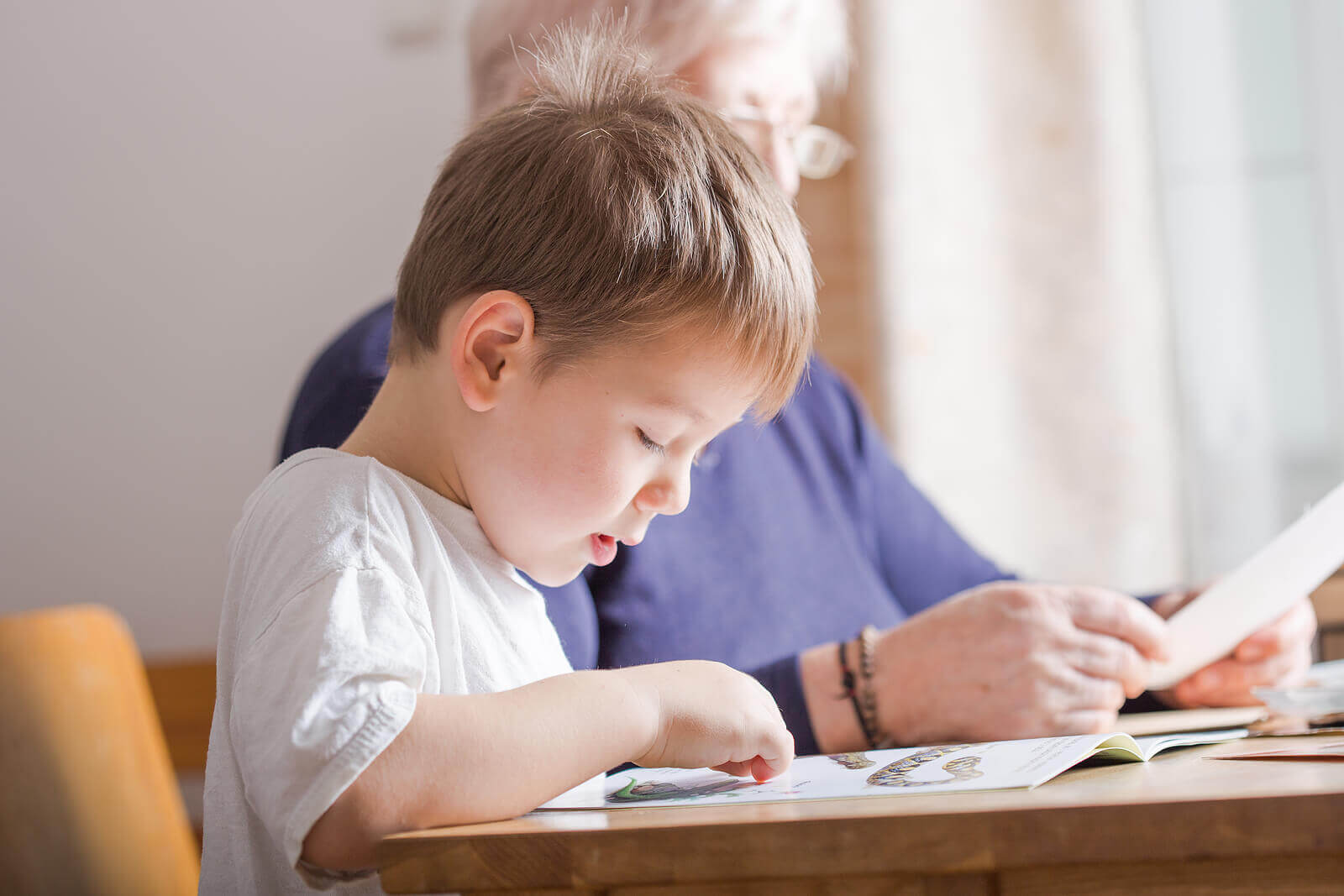10 Ways to Encourage Reading and Writing in Children


Written and verified by the pedagogue Marta Crespo Garcia
Would you like your children to show an interest in reading and writing from the time they’re small? Are you at a loss regarding how to do it? Look no further! Today, we’ll present 10 ways to encourage reading and writing in children in a natural way. These ideas will help you both before your little ones start school and once they’ve already entered the education system.
Now, in order for children to feel involved and interested in reading and writing, we need to provide them with situations and contexts that stimulate their taste for these activities. And when it comes to this task, the role that families play is fundamental. Monserrat Fons suggest 10 ideas for encouraging reading and writing in our children. Let’s take a look!
10 ways to encourage reading and writing in children

Living in a scholarly world
Reading and writing are communicative activities that are part of our sociocultural context. Therefore, it’s important and necessary for learners to live with adults that use reading and writing frequently. That way, they’ll learn to discover and value the significance of these capacities.
Simple activities like writing a grocery list, following a recipe, leaving a note, or reading a story, etc. All of these help to encourage reading and writing in children because they make these abilities significant.
In fact, even symbolic play gives children the possibility of imitating the reading and writing behaviors that children see in their home and school.
Facilitating interrelated learning
Reading and writing are processes that we must teach holistically and not in an isolated fashion. If we practice complete reading and writing experiences with children, it will be much more meaningful for them.
What’s more, it’s best to create and facilitate context in which children reflect on the function of language. Not only written language but oral language as well. That way, they progressively learn the characteristics of each type of text. Letters, recipes, news, congratulations, stories, etc.
Reading out load for new readers
The simple act of listening to texts read by expert readers has a beneficial effect on little ones. This activity helps familiarize them with the reading of the written text as well as language.
In the same way, it’s important to encourage children to participate in the reading process. As we read, we should invite them to participate. For example, we can ask them questions or invite them to relate what they’re hearing with the pictures they see.
This way, we’ll be encouraging the understanding of texts before children can even read. What’s more, reading together with children creates a very important emotional bond. And this, in turn, helps children view reading as a pleasant experience.
Writing along with our children
It’s important to write along with our children. We have to help them understand the usefulness and social functionality of writing on a daily basis.
Therefore, we must teach and explain to children the importance of writing well so that others can understand written texts. We should explain to them the importance of thinking about what they want to say and to whom they want to say it, before starting to write, as well as the importance of re-reading what has been written in order to improve it.
Keeping in mind the relationship between oral and written language
As we well know, we learn to speak before we learn to write. However, as children develop their oral language, it’s beneficial for us to initiate and provide situations in which they’re in contact with the written language.
Little by little, they must understand that the set of letters they see written doesn’t represent the objects, but the name of the object. This is because children believe that what doesn’t exist or what they don’t know cannot be written.
Similarly, children must understand that writing isn’t the same as speaking. Many rules are different; although writing can be oralized, it doesn’t coincide entirely with oral language.
“Reading maketh a full man; conference a ready man; and writing an exact man.”
– Francis Bacon –
More ways to encourage reading and writing in children

Encouraging children to experiment with reading and writing
We must stimulate and motivate children, in any context, to experiment and investigate with reading and writing. In this way, we’ll encourage autonomy in their learning.
We must always motivate them, but not force them, to try to read and write. Even if children say they don’t know how to do it well, we must encourage and help them. And then we’ll be amazed by their good work. In addition, if we offer them an environment of safety and confidence, they’ll understand their mistakes as a means of learning.
Considering the value of time and waiting
Learning to read and write is a long and complex process. It takes time and patience, and, as we know, each child has his or her own pace for learning.
Normally, reading begins between the ages of 5 and 7. However, children who started at 7 can be just as good readers as those who started at 5.
We need to let children investigate, discuss, and rehearse for themselves. If we adults rush into answers and don’t let them think, we’ll make children dependent on our explanations.
Valuing success over mistakes
We must adjust the way we assess children’s successes. If we say, “very good,” we have to specify and tell him what they’ve done well. For example: “You’ve written very clearly” or “You’ve written many letters.”
The generic “very good” gives encouragement, but does little to help children learn. If we want little ones to become aware of their learning, we must recognize and name what they’ve done well.
Using materials from your surroundings
Our surroundings are full of great materials with which to teach children to read and write. The best ones are those we encounter every day. For example, store signs, candy wrappers, restaurant menus, advertisements newspapers…
There’s a great variety of contexts where we can initiate and motivate children in learning to read and write. Moreover, in this way, children will come into contact with different types of supports and typographies.
Talking about reading and writing
In order for children to progress in learning to read and write, it’s good to set up collaborative reading and writing situations. Doing so facilitates a verbal interaction that helps to build learning.
At the same time, it’s enriching to talk about their favorite books, about news that’s of interest to them, playing with words, etc., as something habitual, even if they’re not reading or writing at the moment.
What to keep in mind regarding how to encourage reading and writing in children
During the earliest educational experiences, we must present reading and writing as creative and playful activities. Likewise, we should avoid presenting them as mandatory tasks. After all, we’re trying to get little ones interested and passionate about these activities.
It’s important that children have contact with reading and writing before starting school. This isn’t difficult, since, as we’ve seen, there are many possibilities for learning in their everyday environment. However, the act of reading and writing should always be presented as a game, not as an obligation to learn hastily.
Would you like your children to show an interest in reading and writing from the time they’re small? Are you at a loss regarding how to do it? Look no further! Today, we’ll present 10 ways to encourage reading and writing in children in a natural way. These ideas will help you both before your little ones start school and once they’ve already entered the education system.
Now, in order for children to feel involved and interested in reading and writing, we need to provide them with situations and contexts that stimulate their taste for these activities. And when it comes to this task, the role that families play is fundamental. Monserrat Fons suggest 10 ideas for encouraging reading and writing in our children. Let’s take a look!
10 ways to encourage reading and writing in children

Living in a scholarly world
Reading and writing are communicative activities that are part of our sociocultural context. Therefore, it’s important and necessary for learners to live with adults that use reading and writing frequently. That way, they’ll learn to discover and value the significance of these capacities.
Simple activities like writing a grocery list, following a recipe, leaving a note, or reading a story, etc. All of these help to encourage reading and writing in children because they make these abilities significant.
In fact, even symbolic play gives children the possibility of imitating the reading and writing behaviors that children see in their home and school.
Facilitating interrelated learning
Reading and writing are processes that we must teach holistically and not in an isolated fashion. If we practice complete reading and writing experiences with children, it will be much more meaningful for them.
What’s more, it’s best to create and facilitate context in which children reflect on the function of language. Not only written language but oral language as well. That way, they progressively learn the characteristics of each type of text. Letters, recipes, news, congratulations, stories, etc.
Reading out load for new readers
The simple act of listening to texts read by expert readers has a beneficial effect on little ones. This activity helps familiarize them with the reading of the written text as well as language.
In the same way, it’s important to encourage children to participate in the reading process. As we read, we should invite them to participate. For example, we can ask them questions or invite them to relate what they’re hearing with the pictures they see.
This way, we’ll be encouraging the understanding of texts before children can even read. What’s more, reading together with children creates a very important emotional bond. And this, in turn, helps children view reading as a pleasant experience.
Writing along with our children
It’s important to write along with our children. We have to help them understand the usefulness and social functionality of writing on a daily basis.
Therefore, we must teach and explain to children the importance of writing well so that others can understand written texts. We should explain to them the importance of thinking about what they want to say and to whom they want to say it, before starting to write, as well as the importance of re-reading what has been written in order to improve it.
Keeping in mind the relationship between oral and written language
As we well know, we learn to speak before we learn to write. However, as children develop their oral language, it’s beneficial for us to initiate and provide situations in which they’re in contact with the written language.
Little by little, they must understand that the set of letters they see written doesn’t represent the objects, but the name of the object. This is because children believe that what doesn’t exist or what they don’t know cannot be written.
Similarly, children must understand that writing isn’t the same as speaking. Many rules are different; although writing can be oralized, it doesn’t coincide entirely with oral language.
“Reading maketh a full man; conference a ready man; and writing an exact man.”
– Francis Bacon –
More ways to encourage reading and writing in children

Encouraging children to experiment with reading and writing
We must stimulate and motivate children, in any context, to experiment and investigate with reading and writing. In this way, we’ll encourage autonomy in their learning.
We must always motivate them, but not force them, to try to read and write. Even if children say they don’t know how to do it well, we must encourage and help them. And then we’ll be amazed by their good work. In addition, if we offer them an environment of safety and confidence, they’ll understand their mistakes as a means of learning.
Considering the value of time and waiting
Learning to read and write is a long and complex process. It takes time and patience, and, as we know, each child has his or her own pace for learning.
Normally, reading begins between the ages of 5 and 7. However, children who started at 7 can be just as good readers as those who started at 5.
We need to let children investigate, discuss, and rehearse for themselves. If we adults rush into answers and don’t let them think, we’ll make children dependent on our explanations.
Valuing success over mistakes
We must adjust the way we assess children’s successes. If we say, “very good,” we have to specify and tell him what they’ve done well. For example: “You’ve written very clearly” or “You’ve written many letters.”
The generic “very good” gives encouragement, but does little to help children learn. If we want little ones to become aware of their learning, we must recognize and name what they’ve done well.
Using materials from your surroundings
Our surroundings are full of great materials with which to teach children to read and write. The best ones are those we encounter every day. For example, store signs, candy wrappers, restaurant menus, advertisements newspapers…
There’s a great variety of contexts where we can initiate and motivate children in learning to read and write. Moreover, in this way, children will come into contact with different types of supports and typographies.
Talking about reading and writing
In order for children to progress in learning to read and write, it’s good to set up collaborative reading and writing situations. Doing so facilitates a verbal interaction that helps to build learning.
At the same time, it’s enriching to talk about their favorite books, about news that’s of interest to them, playing with words, etc., as something habitual, even if they’re not reading or writing at the moment.
What to keep in mind regarding how to encourage reading and writing in children
During the earliest educational experiences, we must present reading and writing as creative and playful activities. Likewise, we should avoid presenting them as mandatory tasks. After all, we’re trying to get little ones interested and passionate about these activities.
It’s important that children have contact with reading and writing before starting school. This isn’t difficult, since, as we’ve seen, there are many possibilities for learning in their everyday environment. However, the act of reading and writing should always be presented as a game, not as an obligation to learn hastily.
All cited sources were thoroughly reviewed by our team to ensure their quality, reliability, currency, and validity. The bibliography of this article was considered reliable and of academic or scientific accuracy.
- Baquero Araque, M. C. (2010). Elaboración y aplicación de una guía para establecer nociones de direccionalidad mediante el juego en los niños de 5 a 6 años en la escuela club rotario en el periodo 2008-2009. http://repositorio.utc.edu.ec/bitstream/27000/311/1/T-UTC-0301.pdf
- Bueno Loja, M. I., & Sanmartín Morocho, M. A. (2015). Las rimas, trabalenguas y canciones como estrategias metodológicas para estimular el desarrollo del lenguaje en niños y niñas de 3 a 4 años de edad del Centro Infantil del Buen Vivir” Ingapirca”, de la comunidad de Ingapirca de la parroquia Santa Ana, cantón Cuenca, provincia del Azuay (Bachelor’s thesis).
- Caparros, E. (2008). La lectoescritura. https://archivos.csif.es/archivos/andalucia/ensenanza/revistas/csicsif/revista/pdf/Numero_25/EMILIA_ROSALIA_BUSTOS_CAPARROS02.pdf
- Fons, M. (2004). Enseñar a leer para vivir. Universidad de Barcelona. España: Recuperado de org. file. php/1/documentos/lectoescritura/leer_para_vivir. pdf.
- Granada, I. K. (2009). Didáctica de la enseñanza de la caligrafía expresiva en niños de primaria (Doctoral dissertation, Pereira: Universidad Tecnológica de Pereira). https://repositorio.utp.edu.co/items/dae64522-56a1-4a93-95f7-38ceab0a5a2f
- Guillín Verdesoto, B. C. (2014). Actividades lúdicas en el desarrollo de las nociones espaciales en los niños y niñas de 4 a 5 años, de nivel inicial 2, de la Escuela Matilde Hidalgo de Prócel Quito, período 2013-2014 (Bachelor’s thesis, Quito: UCE).
- Mamani Quispe, J. J. (2019). El ritmo y su aplicación a niños del I ciclo de educación inicial. https://repositorio.une.edu.pe/bitstream/handle/20.500.14039/6135/MONOGRAF%c3%8dA%20-%20MAMANI%20QUISPE%20JOANNY%20JAQUELINE%20-%20FEI.pdf?sequence=1&isAllowed=y
- Paredes Vargas, M. M., & Zumba Montes, M. S. (2011). Elaboración de una guía metodológica de técnicas para la correcta utilización del lápiz en el área de lengua y literatura del segundo año de básica en la escuela Alejandro Dávalos Calle en el cantón Salcedo parroquia San Miguel durante el periodo 2010–2011.
- Por, F. (s. f.). De los Estudios. Recuperado 7 de abril de 2022, de Edu.co website: https://unabvirtual.unab.edu.co/ovas/estrategiaescritura/doc/de_los_Estudios.pdf
- Ramírez Velázquez, Y. (2015). Mi experiencia docente al aplicar actividades didácticas a niños de tercer grado de preescolar para favorecer la lectoescritura. https://dspace.um.edu.mx/bitstream/handle/20.500.11972/878/Yadira%20Ramirez%20(1).pdf?sequence=1
- Ruano Bastián, N. Actividades Didácticas en la Adquisición de la Lectoescritura en Alumnos de Primer Grado de Educación Primaria-Edición Única.
This text is provided for informational purposes only and does not replace consultation with a professional. If in doubt, consult your specialist.








